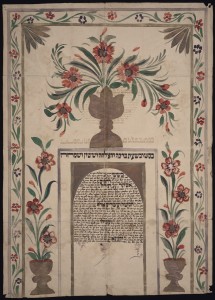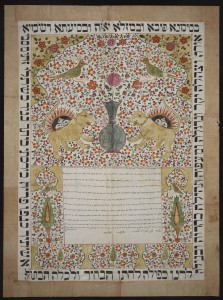The Yale University Library has a large collection of illuminated ketubot (Jewish marriage contracts). Below are some examples from our collection.

Marriage contract, manuscript, ink and paint on paper, dated 3rd of Kislev 5649 (1888) at Yerushalem. Document has a scalloped top with two registers. The lower register contains the text of the ketubah and the upper register contains a vase and branches with flowers. The two registers are bordered by a design of blue leaves with red and yellow flowers.

Marriage contract, manuscript, ink and paint on paper, dated 9th of Nisan, 5665 (1905) at Dameśeḳ. The text is written within an arched gilded border in the bottom half of the document. Above it and on both sides are painted large vases with flowers and borders with floral designs. Beneath the text of the ketubah are the signatures of the two witnesses on either side and the groom’s signature in the center.

Marriage contract, manuscript, ink on vellum, dated 7 Tamuz 5549 at Saloniki, Greece. Surrounding the two columns of text are birds, flowers, fruit, columns, biblical sayings, Eshet Hayil, Shir ha-shirim. The right column contains the marriage terms and the left column contains the betrothal terms. Colors used are brown, with coral & dark grayish blue-green.

Marriage contract, manuscript, ink and paint on paper, dated 12th of Nisan 5616 (1856) at Itsfahan, Iran. Brightly colored elaborate floral illumination surrounds the text. In the center above the text there is a large vase with two lions with a rising sun behind them on either side of the vase, and with two birds above. There is a floral arch on the top of the document and two smaller arches framing the text. The frame of the document contain blessings for the bride and the groom.
Among Yale Library’s extensive collection of sheet music is the Yiddish opera, Bas Sheva.  The opera in Yale’s possession is in manuscript form. The lyrics are romanized, probably because musical notes can only be written from left to right, whereas Yiddish is read from right to left. The title page can be considered a work of art in itself, and in all probability Broderzon is the illustrator. Sometimes called Dovid and Bas-Sheva¸ this opera premiered in Warsaw’s prestigious Kaminski Theater on May 14, 1924. It is not known if it was ever performed again. Moishe Broderzon (1890-1956), the librettist, was born in Moscow but made his home in Lodz, Poland, where he did his most important artistic work. He was involved in just about every aspect of Yiddish culture and art. A poet and a playwright, he helped found a literary journal, a puppet theater, and a cabaret theater. He fled to Russia at the outbreak of World War II. Broderzon was arrested by the Soviet authorities in 1950 and died shortly after being released from a Stalinist labor camp. Henekh Kon (1998-1972) was a composer of musical theater and film. He is probably best known as the composer of the musical score for the Yiddish film The Dybbuk, based on S. Ansky;s play. Kon was a major figure in the Polish-Jewish cultural scene of the interwar period. He worked with Broderzon in founding the Chad Gadya marionette theater in Lodz (1922) and the Azazel (1925), Sambatyon (1926), and Ararat (1927) theaters in Warsaw. Kon left Poland before World War II and moved to New York. He thus survived the terrible fate that befell other Yiddish artists and intellectuals who were swept up in the Nazi inferno or the Stalinist persecutions. The Yale Library’s large collection of Yiddish and Hebrew sheet music is housed in the Gilmore Music Library.
The opera in Yale’s possession is in manuscript form. The lyrics are romanized, probably because musical notes can only be written from left to right, whereas Yiddish is read from right to left. The title page can be considered a work of art in itself, and in all probability Broderzon is the illustrator. Sometimes called Dovid and Bas-Sheva¸ this opera premiered in Warsaw’s prestigious Kaminski Theater on May 14, 1924. It is not known if it was ever performed again. Moishe Broderzon (1890-1956), the librettist, was born in Moscow but made his home in Lodz, Poland, where he did his most important artistic work. He was involved in just about every aspect of Yiddish culture and art. A poet and a playwright, he helped found a literary journal, a puppet theater, and a cabaret theater. He fled to Russia at the outbreak of World War II. Broderzon was arrested by the Soviet authorities in 1950 and died shortly after being released from a Stalinist labor camp. Henekh Kon (1998-1972) was a composer of musical theater and film. He is probably best known as the composer of the musical score for the Yiddish film The Dybbuk, based on S. Ansky;s play. Kon was a major figure in the Polish-Jewish cultural scene of the interwar period. He worked with Broderzon in founding the Chad Gadya marionette theater in Lodz (1922) and the Azazel (1925), Sambatyon (1926), and Ararat (1927) theaters in Warsaw. Kon left Poland before World War II and moved to New York. He thus survived the terrible fate that befell other Yiddish artists and intellectuals who were swept up in the Nazi inferno or the Stalinist persecutions. The Yale Library’s large collection of Yiddish and Hebrew sheet music is housed in the Gilmore Music Library.
A group of manuscripts that we have assembled over a period of several years is the rabbinic emissaries collection. In Hebrew they were referred to as shadarim, an acronym for shilluhe de-rabbanan.
![Rabbinic emissary document from Tiberias to communities in Tunisia and Libya, 1922. Large manuscript on parchment, dated 5682 [1922], intended as a letter of introduction in which the great sages of Tiberias authorize Rabbi Yaʻaḳov Ṿaḳnin to collect funds for the needy of that city. The first five paragraphs each begin and end with the same word. The top of the document is scalloped with the center taking the form of an arch. The calligraphy is beautifully executed, indicating that the document was probably written by a professional scribe. The document bears the signatures and official stamps of over forty rabbis from the Maghrebi community in Tiberias. The letter is addressed to rabbis and leaders of the large centers of Jewish settlement in Tunisia and Libya. The great Talmudic sage Rabbi Meir, also known as Rabbi Meir Baal ha-Nes, whose tomb is in Tiberias, is referred to frequently to add more gravity to the request of the emissary and the rabbis who sent him.](https://campuspress.yale.edu/judaicacollection/files/2013/11/2012-10-03_12-15-07_686-169x300.jpg)
Rabbinic emissary document from Tiberias to communities in Tunisia and Libya, 1922.
Large manuscript on parchment, dated 5682 [1922], intended as a letter of introduction in which the great sages of Tiberias authorize Rabbi Yaʻaḳov Ṿaḳnin to collect funds for the needy of that city.
This calligraphic masterpiece, 11-inch high piece of parchment that contains the entire biblical Song of Songs in Hebrew micrography (written in tiny letters). It is signed by the Lithuanian artist/scribe, Baruch ben Shemaryah, 1794. It renders the entire Song of Songs as a work of art, in letters that are at once text and illumination. Shir (song) is the central word around which the text revolves. The crown, labeled “crown of kingship” perhaps refers to the Song’s opening statement that its author is King Solomon.
Religious authorities in both Judaism and Christianity made the Song’s prominence possible by interpreting it allegorically, as an expression of God’s love. The document’s chronogram—Hebrew words whose numerical value indicates the date—uses ahavat olam: eternal love. It may refer to a prayer about God’s love for Israel which begins with these words; or it may mean that the document was created in honor of a marriage. For, in everyday usage and in its plain meaning, the Song of Songs is about spring, youth, love, and yearning.
In addition to the collection of Judaica books in the library, we have been collecting manuscripts of various kinds that are of interest to scholars. These different genres of materials enhance the Judaica Collection by providing library patrons with materials that are unique to Yale. Since the library’s holdings are cataloged online, knowledge of these items is accessible to scholars all over the world.
The largest of our manuscript collections are the Jewish community registers from Europe. These registers, known in Hebrew as pinkase kehilah, were produced by synagogue congregations, study societies, charitable societies and burial societies (the hevra kadisha). The pinkasim (pl.) in Yale’s collection originate primarily in Eastern and Central Europe (mostly Hungary and Romania). The contents consist of proceedings of meetings, regulations and by-laws, records of monetary contributions, and the recording of births and deaths. The title page of many of them are elaborately written and decorated. They are an excellent primary resource for the study of the economic, social and religious life of Jewish communities in Eastern and Central Europe in the 19th and early 20th centuries. They originated in the large centers of Jewish life but also in small out-of-way communities. They thus shed light on Jewish life in geographic locations where there is precious little other information available. There are pinkasim in the collection that contain records that go up to the early 1940s, the point at which these communities were destroyed by the Nazis.
The community register collection serves as a complement to Yale’s large collection of yizkor books, memorials to the destroyed Jewish communities of Europe during the Sho’ah. These are works that were by-and-large compiled by survivors of those towns. Those that remained alive at the end of the war attempted to evoke the towns of their birth in earlier times when those towns were still vibrant and active. In addition to the many essays concerning the village, town, or city found in these books, the compilers also included photos of members of the various Zionist groups, sports clubs, school graduations, family outings, socialist or Bundist gatherings, and other events in the life of their community. The yizkor books celebrate the life of European Jewish communities that were brutally destroyed; the community register collection serve to shed further light on many of those communities. A list of most of Yale’s holdings can be found at: http://www.library.yale.edu/judaica/site/collection/yizkorbooks.php






![Rabbinic emissary document from Tiberias to communities in Tunisia and Libya, 1922. Large manuscript on parchment, dated 5682 [1922], intended as a letter of introduction in which the great sages of Tiberias authorize Rabbi Yaʻaḳov Ṿaḳnin to collect funds for the needy of that city. The first five paragraphs each begin and end with the same word. The top of the document is scalloped with the center taking the form of an arch. The calligraphy is beautifully executed, indicating that the document was probably written by a professional scribe. The document bears the signatures and official stamps of over forty rabbis from the Maghrebi community in Tiberias. The letter is addressed to rabbis and leaders of the large centers of Jewish settlement in Tunisia and Libya. The great Talmudic sage Rabbi Meir, also known as Rabbi Meir Baal ha-Nes, whose tomb is in Tiberias, is referred to frequently to add more gravity to the request of the emissary and the rabbis who sent him.](https://campuspress.yale.edu/judaicacollection/files/2013/11/2012-10-03_12-15-07_686-169x300.jpg)
